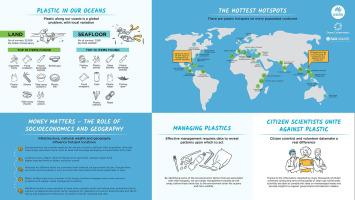Global Environmental Change ( IF 8.6 ) Pub Date : 2021-09-15 , DOI: 10.1016/j.gloenvcha.2021.102360 Britta Denise Hardesty 1 , Lauren Roman 1 , George H. Leonard 2 , Nicholas Mallos 2 , Hannah Pragnell-Raasch 3 , Ian Campbell 3 , Chris Wilcox 1

|
Pollution of coastal environments by anthropogenic debris is a global problem that is increasingly in the public eye. We evaluated the influence of socioeconomic and geographic factors on common debris items at a global scale. We compared debris density and socioeconomic drivers of the ten most common items reported on land and the seafloor, analyzing data from 22,508 land-based and 7,290 seafloor clean-ups and surveys across 116 and 118 countries, respectively. We found debris hotspots for different items span numerous countries across all continents. This demonstrates that the debris problem is global and heterogeneous, pointing to the transboundary nature of the issue and necessitating sub-national approaches to implementing effective solutions. Food and beverage packaging items, predominantly made from single-use plastics, accounted for much of the debris. Hotspots of individual debris items were differentially driven by socioeconomic factors. In general, total debris counts increased with the value of infrastructure, and decreased with national wealth. Highly polluted sites occurred in high-infrastructure, low-wealth locations such as Athens, Greece; Tunis, Tunisia and Lima, Peru. Based on these findings, we identify specific opportunities for policy makers and citizens alike to focus efforts aimed at reducing debris entering the environment.
中文翻译:

社会经济学对陆地和海底常见碎片项目全球热点的影响
人为垃圾对沿海环境的污染是一个日益受到公众关注的全球性问题。我们在全球范围内评估了社会经济和地理因素对常见碎片项目的影响。我们比较了陆地和海底报告的十个最常见项目的碎片密度和社会经济驱动因素,分析了分别来自 116 个和 118 个国家/地区的 22,508 次陆地和 7,290 次海底清理和调查的数据。我们发现不同物品的碎片热点跨越各大洲的许多国家。这表明碎片问题具有全球性和多样性,表明该问题具有跨界性质,需要采取次国家级方法来实施有效的解决方案。食品和饮料包装物品,主要由一次性塑料制成,占了大部分的碎片。单个碎片项目的热点受社会经济因素的不同驱动。一般来说,碎片总数随着基础设施价值的增加而增加,随着国家财富的增加而减少。高污染场地出现在基础设施高、财富低的地区,如希腊雅典;突尼斯,突尼斯和利马,秘鲁。根据这些发现,我们为政策制定者和公民等确定了特定机会,以集中努力减少进入环境的碎片。突尼斯和秘鲁利马。根据这些发现,我们为政策制定者和公民等确定了特定机会,以集中努力减少进入环境的碎片。突尼斯和秘鲁利马。根据这些发现,我们为政策制定者和公民等确定了特定机会,以集中努力减少进入环境的碎片。











































 京公网安备 11010802027423号
京公网安备 11010802027423号